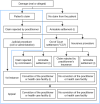Medicolegal issues of peri-anaesthetic dental injuries: A 21-years review of liability lawsuits in France
- PMID: 35639817
- PMCID: PMC9539868
- DOI: 10.1111/edt.12770
Medicolegal issues of peri-anaesthetic dental injuries: A 21-years review of liability lawsuits in France
Abstract
Background/aim: Peri-anaesthetic dental injuries (PDI) represent a major source of potential malpractice claims against anesthesiologists. Studies about the medico-legal aspects of PDI have mainly focused on liability insurance cases thus not encompassing those cases brought to court. The aim of this study was to assess the medico-legal issues of PDI-related liability lawsuits in France.
Material and methods: A review of judicial decisions pertaining to PDI was conducted on a French legal database, spanning the period between January 2000 and October 2021. Characteristics of decisions, patients and anesthesiologists, peri-operative care, dental injuries, and convictions were collected when available for analysis.
Results: Twenty-four judicial decisions fulfilled the inclusion criteria and were analyzed. All cases of dental injuries took place during elective surgery, 16 in the private sector and 8 in the public sector. Most injuries concerned two or more teeth and the most predominant dental injuries were luxation or avulsion (70.8% of cases). Eight cases resulted in a final verdict in favor of the plaintiff, four in the private sector (conviction rate: 25%), and four in the public sector (conviction rate: 50%). The causes of conviction were either a lack of information (5/8), a breach in the standard of care or technical negligence (3/8). The average amount of indemnification for the plaintiff was 3614 Euros (3753 Euros in 2022 inflation-adjusted Euros) excluding legal fees.
Conclusions: The analysis of PDI-related liability lawsuits shows that medico-legal issues differ from those of PDI-related insurance claims. Avulsion and luxation of multiple anterior teeth during elective surgery appear to be a risk factor for liability lawsuits. In addition, inadequacy of patient information about PDI-risk seems to be a risk factor for conviction. Lastly, dental injuries are less at risk of civil conviction than other anesthesia-related damages.
Keywords: anaesthetic risk; dental injury; endotracheal intubation; liability lawsuit; mouthguards.
© 2022 The Authors. Dental Traumatology published by John Wiley & Sons Ltd.
Conflict of interest statement
The authors declare that they have no conflict of interest.
Figures
References
-
- Owen H, Waddell‐Smith I. Dental trauma associated with anaesthesia. Anaesth Intensive Care. 2000;28:133–45. - PubMed
-
- Givol N, Gershtansky Y, Halamish‐Shani T, Taicher S, Perel A, Segal E. Perianesthetic dental injuries: analysis of incident reports. J Clin Anesth. 2004;16:173–6. - PubMed
-
- Newland MC, Ellis SJ, Peters KR, Simonson JA, Durham TM, Ullrich FA, et al. Dental injury associated with anesthesia: a report of 161,687 anesthetics given over 14 years. J Clin Anesth. 2007;19:339–45. - PubMed
-
- Nouette‐Gaulain K, Lenfant F, Jacquet‐Francillon D, Belbachir A, Bournigault‐Nuquet A, Choquet O, et al. French clinical guidelines for prevention of perianaesthetic dental injuries: long text. Ann Fr Anesth Reanim. 2012;31:213–23. - PubMed
-
- Kuo YW, Lu IC, Yang HY, Chiu SL, Hsu HT, Cheng KI. Quality improvement program reduces peri‐operative dental injuries – a review of 64,718 anesthetic patients. J Chin Med Assoc. 2016;79:678–82. - PubMed
Publication types
MeSH terms
Substances
LinkOut - more resources
Full Text Sources
Medical




